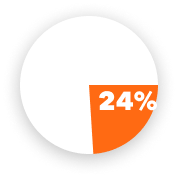Is Selling Over Video Harder Than Selling in Person?
We surveyed 640+ B2B buyers and sellers for our 2023 Virtual Selling Report, and the data points to yes:


of sellers said, “I feel less confident when selling on a video call.”
Compared to team leaders and senior sales leaders, individual contributors (AEs) are more likely to agree that virtual selling saps their confidence.
 So what is it, exactly, about selling over video that deflates seller confidence?
So what is it, exactly, about selling over video that deflates seller confidence?
There are four forces that make virtual selling difficult.
1. Low Visibility Causes AEs to Miss Non-verbal Buyer Cues.
In-person selling requires looking at your buyers eye-to-eye. If they raise an eyebrow or lean forward, the average salesperson is able to read those cues. She’s skeptical. He’s interested.
Virtual selling with video conferencing technology reduces life-sized buyers to tiny faces framed in gallery view, making it hard to see non-verbal buyer reactions.


of virtual sellers agree: “I can’t see buyer facial expressions and reactions.”
AEs may miss non-verbal cues entirely when presenting slides or looking into the camera to give the illusion of eye contact. And the majority of sellers do both.


of virtual sellers agree: “I share my screen to present slides.”


of virtual sellers agree: “I find myself presenting to the camera/green light.”
Why does this matter?
Sellers are flying blind in this new world; they are missing non-verbal cues that indicate negative buyer sentiment and low buyer engagement. So sellers present on, never pausing to explore what might be causing sentiment or engagement to decline. And as our research uncovered, sentiment and engagement levels impact deal outcomes. When selling over video, low visibility causes AEs to miss non-verbal buyer cues. Read the report.


2. Sellers Lose Their Ability to “Work the Room” Using Body Language and Eye Contact.
The archetypal sales rep drips confidence and charm.
But when in-person account executives transition to a virtual selling environment, they may lose their ability to “work the room” using body language and eye contact.


of virtual sellers agree: “I can’t use body language like I would in person.”


of virtual sellers agree: “I can’t make eye contact like I would in person.”
Why is this happening?
A report from The Predictive Index found that in a remote environment, extraverted employees are less likely than other employees to feel sure they’re taking correct action. Why? People with social behavioral profiles often communicate through body language and eye contact, and this is harder to do over video conferencing software. When selling over video, AEs lose their ability to “work the room” using body language and eye contact.
3. Buyers Don’t Reveal What They’re Really Thinking or Feeling.
Not all buyers are fully transparent about what they’re thinking and feeling.


of sellers agree: “Buyers don’t always tell you what they’re thinking.”


of sellers agree: “Buyers say things they don’t mean.”
The guessing game is par for any seller’s course; this isn’t a problem that’s specific to virtual selling. But since selling over video decreases the AEs ability to see non-verbal buyer cues, this issue becomes more problematic in a virtual selling environment.
Why does this matter?
When sellers don’t know their buyers’ fears, needs, and motivations, they struggle to steer the conversation in the right direction. Buyer untruths, however non-malicious, prevent sellers from gaining understanding and creating traction: if sellers don’t understand buyer wants, needs, and motivations, they’ll struggle to build rapport, keep buyer attention, and successfully move deals forward.
4. Buyers Multitask on Virtual Sales Calls.
Buyers are busy. Lately, everyone seems to have more work than they can handle. When sellers manage to get buyers on a video call, there’s a good chance they’re multitasking.


of buyers say: “I was multitasking at times during the video call.”


of buyers say: “Some of my co-workers were multitasking during the video call.”
And when buyers turn their cameras off, there’s no knowing if they’re paying attention. For all you know they’ve stepped away from their computer to throw a load of laundry in.


of buyers say: “Some of my co-workers kept their cameras off during the video call.”
Why is this happening?
One study of Microsoft employees showed that people multitask on remote meetings as a coping mechanism to deal with the stress of back-to-back video calls. Interestingly, Microsoft found that the odds of multitasking increase alongside the number of call participants added.
Overcome the Four Forces That Make Virtual Selling Difficult
Download Uniphore’s 2023 virtual selling report to learn which specific seller behaviors and actions drive positive sentiment and high engagement. The report includes 10 actionable recommendations for virtual sellers to help you close more deals and hit your numbers.
)